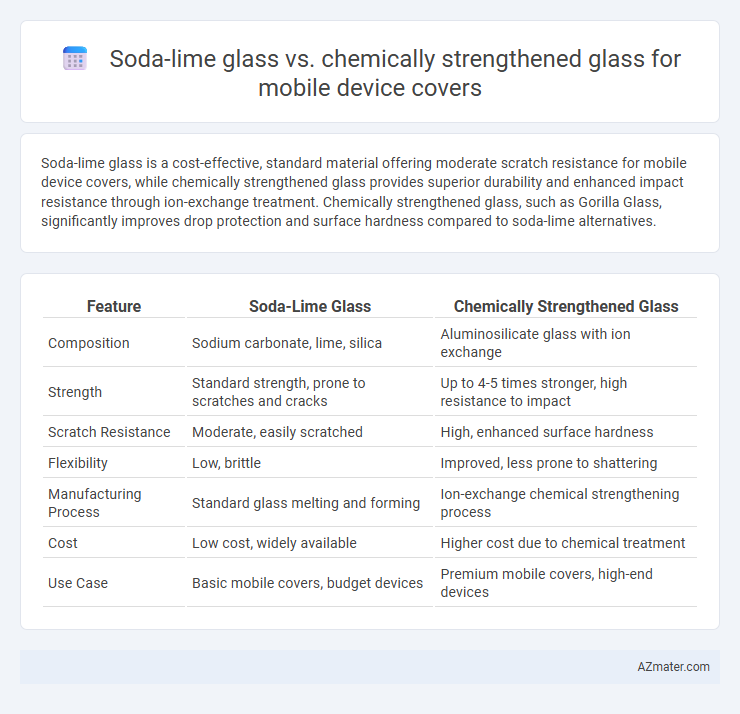Soda-lime glass is a cost-effective, standard material offering moderate scratch resistance for mobile device covers, while chemically strengthened glass provides superior durability and enhanced impact resistance through ion-exchange treatment. Chemically strengthened glass, such as Gorilla Glass, significantly improves drop protection and surface hardness compared to soda-lime alternatives.
Table of Comparison
| Feature | Soda-Lime Glass | Chemically Strengthened Glass |
|---|---|---|
| Composition | Sodium carbonate, lime, silica | Aluminosilicate glass with ion exchange |
| Strength | Standard strength, prone to scratches and cracks | Up to 4-5 times stronger, high resistance to impact |
| Scratch Resistance | Moderate, easily scratched | High, enhanced surface hardness |
| Flexibility | Low, brittle | Improved, less prone to shattering |
| Manufacturing Process | Standard glass melting and forming | Ion-exchange chemical strengthening process |
| Cost | Low cost, widely available | Higher cost due to chemical treatment |
| Use Case | Basic mobile covers, budget devices | Premium mobile covers, high-end devices |
Introduction to Mobile Device Cover Glasses
Mobile device cover glasses primarily include soda-lime glass and chemically strengthened glass, each offering distinct durability and optical qualities. Soda-lime glass, commonly used due to its cost-effectiveness, provides basic scratch resistance but lacks enhanced strength. Chemically strengthened glass, such as aluminosilicate glass, undergoes ion exchange processes, resulting in superior toughness and improved resistance to impact, making it ideal for premium smartphone screens.
What is Soda-Lime Glass?
Soda-lime glass is the most common type of glass used in mobile device covers, composed primarily of silica (SiO2), sodium oxide (Na2O), and calcium oxide (CaO). Its affordability and ease of manufacturing make it a popular choice, but it has lower durability and scratch resistance compared to chemically strengthened glass. While soda-lime glass offers basic protection, chemically strengthened glass undergoes ion-exchange treatment to enhance strength and impact resistance for superior mobile device cover performance.
What is Chemically Strengthened Glass?
Chemically strengthened glass is produced through an ion exchange process where smaller sodium ions in the glass surface are replaced by larger potassium ions, creating a compressive stress layer that enhances strength and resistance to scratches and impacts. This type of glass offers superior durability compared to soda-lime glass, which is commonly used but lacks the enhanced toughness needed for mobile device covers. The improved mechanical properties of chemically strengthened glass make it ideal for protecting smartphones and tablets against daily wear and accidental drops.
Manufacturing Process Comparison
Soda-lime glass is produced through a melting process involving silica, soda ash, and lime, followed by controlled cooling to achieve its basic structure, making it cost-effective but less durable for mobile covers. Chemically strengthened glass undergoes an ion-exchange process where smaller sodium ions in the glass surface are replaced by larger potassium ions from a molten salt bath, significantly enhancing surface compressive stress and improving scratch and impact resistance. This ion-exchange manufacturing method results in a tougher, more resilient mobile device cover compared to the traditional thermal tempering used in soda-lime glass production.
Strength and Durability Analysis
Soda-lime glass, commonly used in mobile device covers, offers moderate strength and is cost-effective but is more prone to scratches and impact damage compared to chemically strengthened glass. Chemically strengthened glass undergoes an ion-exchange process that significantly improves surface compressive stress, resulting in enhanced resistance to scratches, bending, and impact forces. This treatment yields up to a 4-5 times increase in strength and superior durability, making chemically strengthened glass the preferred choice for premium mobile device protection.
Scratch and Impact Resistance
Soda-lime glass offers moderate scratch resistance but is prone to cracking under high impact, making it less durable for mobile device covers. Chemically strengthened glass undergoes an ion-exchange process that significantly enhances its surface hardness and improves both scratch and impact resistance. This superior durability allows chemically strengthened glass to better protect mobile devices from everyday wear and accidental drops.
Cost and Production Efficiency
Soda-lime glass offers low production costs due to its widespread availability and simple manufacturing process, making it economically efficient for large-scale mobile device covers. Chemically strengthened glass, such as aluminosilicate variants, incurs higher costs because of specialized ion-exchange treatments that enhance durability and scratch resistance. Production efficiency for chemically strengthened glass is lower compared to soda-lime, as its complex processes require precise control and longer manufacturing times, impacting overall profitability in mass production.
Optical Clarity and Touch Sensitivity
Chemically strengthened glass offers superior optical clarity due to its uniform surface and reduced microscopic imperfections compared to soda-lime glass, enhancing display brightness and color accuracy for mobile devices. The ion-exchange process in chemically strengthened glass improves touch sensitivity by maintaining a smooth, responsive surface that accurately registers finger input. In contrast, soda-lime glass tends to have lower transmittance and can slightly diminish touch responsiveness due to its less refined surface quality.
Environmental Impact and Sustainability
Soda-lime glass, commonly used in mobile device covers, has a higher carbon footprint due to its energy-intensive raw material extraction and lower recyclability compared to chemically strengthened glass. Chemically strengthened glass, such as aluminosilicate glass, offers enhanced durability reducing device waste and extends product lifespan, contributing to sustainability by minimizing replacement frequency. The chemical strengthening process improves environmental impact by enabling thinner, lighter glass that lowers transportation emissions and resource consumption.
Which Glass is Better for Mobile Devices?
Chemically strengthened glass outperforms soda-lime glass for mobile device covers due to its enhanced durability and higher scratch resistance achieved through ion exchange processes that create compressive stress on the glass surface. Soda-lime glass, while more cost-effective, is more prone to cracks and scratches, making it less suitable for everyday mobile use where impact and abrasion are common. The superior toughness and clarity of chemically strengthened glass make it the preferred choice for manufacturers seeking to improve screen longevity and user experience.

Infographic: Soda-lime glass vs Chemically strengthened glass for Mobile device cover
 azmater.com
azmater.com